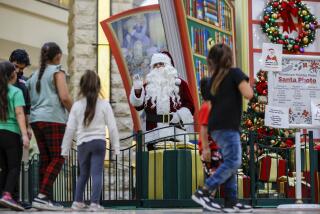Santa Timeline: Before he was cheery and chubby
You may think you know Santa, but thereâs a lot more to the legend than a bag full of presents. What follows is a selective history of St. Nick and how he came to be known as the jolly round man in the iconic red suit.
PHOTOS: A look at the evolution of Santa Claus
AD 280
The man weâve come to identify at St. Nicholas was born in the third century in what is now Turkey. He eventually became a bishop in the early church and was known for helping the poor and the sick and for being a protector of sailors and children. Tales of his good works, including gifts to the poor, start to spread throughout Europe.
1087
Italian sailors or merchants allegedly steal the remains of St. Nicholas from his shrine at a church in Myra (located in present-day Turkey). They bring them to Bari, Italy, increasing the saintâs popularity in Europe. To this day, the remains are enshrined in the 11th century basilica of San Nicola in Bari.
Renaissance
St. Nicholas becomes one of the most popular saints in Europe. People celebrate his feast on Dec. 6, which, legend has it, is the anniversary of his death. Even during the Protestant Reformation, when the adoration of saints is discouraged, St. Nicholas remains a popular saint in Holland.
17th century
Dutch immigrants bring stories of St. Nicholas to the United States, referring to him as Sinter Klaas, which eventually evolves into Santa Claus. His outfits vary; garments include a red waistcoat (inspired by the red cloak that bishops wore), Flemish trunk hose, a blue three-cornered hat, yellow stockings and a broad-brimmed hat.
1820s
The Dutch in Pennsylvania speak of a figure named Belsnickle or âKris Kringle, âderived from the German âChristkindâ (Christ child). The stories say that Belsnickle travels the countryside, ringing a bell, and delivering small gifts to the good children and spanking the bad ones. (Similarly, in Germany during Christmas time, the Christkind, or an angel is believed to travel to childrenâs homes and deliver gifts.)
1822
Episcopal minister Clement Clarke Moore writes a poem titled âAn Account of a Visit From St. Nicholasâ for his three daughters. Moore portrays Santa as a âright jolly old elfâ who flies from house to house on Christmas Eve. Mooreâs poem becomes popular and the basis for how Santa is characterized in the U.S. âEight tiny reindeerâ are immortalized.
1840s
Major publications begin to create separate sections for holiday shopping advertisements. These ads feature images of a large man with a white beard in a red suit similar to the Santa depicted in the Moore poem. In 1841 a shop in Philadelphia uses a life-size Santa Claus model to draw thousands of children to the store.
1862
Political cartoonist Thomas Nast draws a picture of Santa Claus to accompany âAn Account of a Visit From St. Nicholas.â The illustration runs in Harperâs Weekly and depicts Santa with a portly figure, a white beard, a fur-trimmed red suit and a sack full of childrenâs toys.
1890s
The Salvation Army begins dressing unemployed men in Santa suits to solicit donations in New York.
1931
Illustrator Haddon Sundblom draws a series of Santa images for the Coca-Cola Co. Used in all the companyâs Christmas advertisements, the character becomes the modern-day version of Santa.
More to Read
Sign up for Essential California
The most important California stories and recommendations in your inbox every morning.
You may occasionally receive promotional content from the Los Angeles Times.











